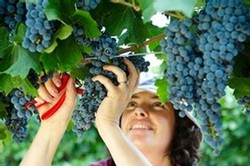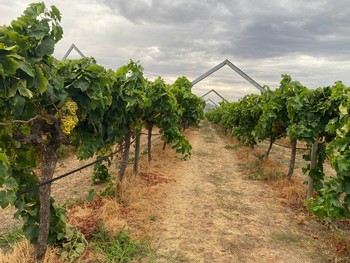What's the difference between Wine Grapes and Table Grapes?
If you’ve ever wondered why you can’t head to your local fruit and veg store, pick up some red or green grapes, bring them home, crush them and turn them into wine, you’re not alone.
The burning question is, what’s the actual difference between table grapes and wine grapes?
The answer? A lot, actually.
So, let’s wander into the vineyard to unravel the age-old mystery:
what sets wine grapes apart from their table grape cousins?
Let's look at the grapes:
Upper Reach stands as a testament to the art and science that goes into crafting each bottle of wine.
But before we pour that white or red into our glasses, we need to understand the stars of the show– the grapes themselves.
Appearance: Amall but Mighty vs Big & Juicy?

First things first, let's talk about appearances.
Wine grapes and table grapes may look similar at first glance.
But upon closer inspection, you'll notice some distinct differences.
- Wine Grapes: Smaller, thicker skins and are packed with seeds. While they may not be the ideal Netflix snack, they are perfect for producing rich, flavourful wines.
- Table Grapes: Larger, juicier and generally seedless. Their thin skins and juicy flesh make them ideal for salads and snacks, but they lack the intensity and complexity needed for winemaking.
Taste: Complexity vs Sweetness
 The taste profile of grapes is (of course) another defining factor:
The taste profile of grapes is (of course) another defining factor:
- Wine Grapes: Carefully cultivated to achieve specific flavour profiles.
At Upper Reach we love the boldness of the Reserve Shiraz, the plushness of the Cabernet Sauvignon Merlot and the complexity of the Reserve Chardonnay.
Wine grapes balance sugar, acid, and tannin to create harmonious flavours to tantalise your taste buds.
- Table Grapes: Are all about sweetness. Whilst delicious, table grapes are all about providing a burst of sugary goodness with every bite. Think of them as nature's sweet treat- plump, juicy and very moreish.

Trellising Styles: Sun vs Shade
Even the way the grapes are grown differs:
- Wine Grapes: Grow along vertical trellises to ensure each grapes ripens to perfection under the sun.
- Table Grapes: Often grown on Y-shaped trellises that provide shade, helping the fruit grow larger and juicier while protecting it from excessive sun exposure.
Destiny: Glass vs Bowl
But perhaps the most significant difference lies in their future.
- Wine Grapes: Destined for greatness, these grapes will be transformed by our winemakers into bottles of wine that tell a story with every sip.
- Table Grapes: Meant for immediate consumption, whether enjoyed fresh, added to salads or turned into jams and jellies.
Appreciate the humble grape
Next time you find yourself wandering through the Swan Valley's vineyards, take a moment to appreciate the humble grape – whether it's destined for your wine glass or your fruit bowl.